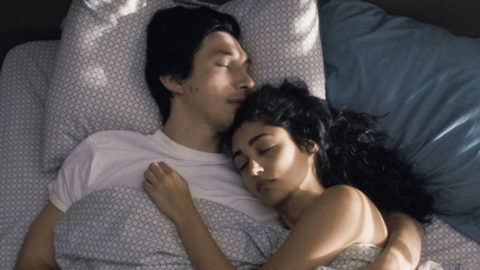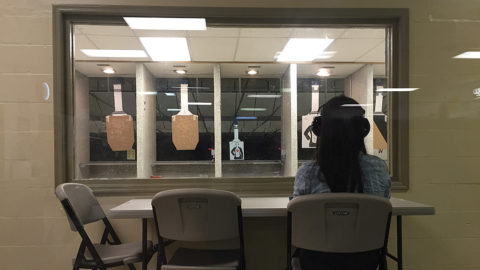Deep Focus: Christine
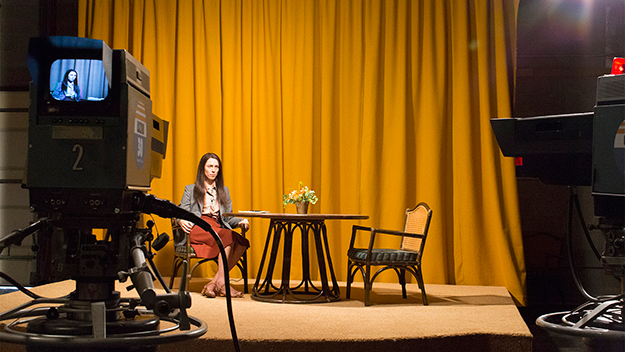
The anti-heroine of Antonio Campos’s Christine, Christine Chubbuck, is a driven, idealistic reporter at a tiny Sarasota, Florida UHF station in the mid-1970s, who’s striving to perfect her craft and advance her career while serving her adopted community for her signature public-affairs show, Suncoast Digest. Christine (Rebecca Hall) lives with her divorced mother Peg (J. Smith-Cameron), volunteers as a puppeteer to entertain and educate disabled children, and hopes that a handsome coworker, George Peter Ryan (Michael C. Hall), a savvy fellow with a twinkle in his eye, might have a gleam just for her.
She’s been at the station for a year when, as screenwriter Craig Shilowich tells it, the fabric of her life comes apart, just before she turns 30. Her boss (Tracy Letts) takes up the brand-new guideline “If it bleeds, it leads” and devalues the careful, constructive work she’s been doing on zoning regulations and the environment. While Peg readily strikes up a relationship with a new man, Christine has yet to have a single date. She feels piercing abdominal pain, experiences spotting, and worries about her ability to have children. Even her work friend Jean Reed (Maria Dizzia), a segment producer and camerawoman, commits what Chris regards as a professional betrayal. On top of that, the station’s owner (John Cullum) comes looking for talent to move up to his station in Baltimore (a top 30 market). While all this is happening, George finally asks her out for dinner and promises to take her someplace where they “can talk.” By the time she buys a gun, you know she’s going to use it, and not on anybody else.
With its lightning-round rendering of the precipitous dips in a pathos-riddled life, Christine operates like a socially conscious docudrama on steroids. It limns the pressures a Seventies woman would put on herself “to have it all” while it assembles a critique of the sensationalism that local TV stations fell into with the rise of “eyewitness news teams.” But the movie neither gels nor clarifies its points as it goes along. Compelling moment by moment, it ends up a blood-streaked blur.
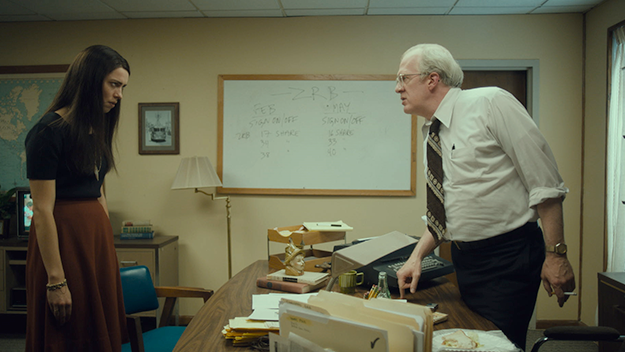
Christine Chubbuck is, of course, the broadcaster who sat at the WXLT anchor desk in Sarasota on July 15, 1974, and announced, “In keeping with Channel 40’s policy of bringing you the latest in ‘blood and guts’, and in living color, you are going to see another first—attempted suicide.” Then she shot herself behind her right ear. The movie banks that our mixture of fascination and dread will keep us pinned to our seats. Even viewers ignorant of the outcome will recognize that Christine is in a death spiral. The film isn’t exploitative. Hall’s all-in performance projects Chubbuck’s weaknesses as well as her strengths without any editorial underlining. With steely ambition and rampaging insecurity, Hall’s Christine combines professionalism, intelligence, and even some artistic intuition. She pushes Jean to add a final bit of film to a segment seconds before airtime. But she isn’t a broadcast natural. She reads copy expertly but rigidly. Her enunciation is impeccable; her emphases and little jokes perfectly calibrated. Her posture is rigid and her demeanor inexpressive.
Campos and Shilowich whip up narrative momentum without relying on our rooting interest for Christine, who is alternately sympathetic and excruciating. The movie compresses events to achieve pressure-cooker intensity. It alters details for the same reason—for example, according to Sally Quinn’s exhaustive report in the August 4, 1974 Washington Post, George was not a star news anchor but a stockbroker who came in to read stock reports on the station’s news shows. But the film is hardly manipulative, meretricious, or clinical. It lets us discover Christine’s psychological history along the way. She confesses to her doctor that she took—and disliked—antidepressants. During a rant against her mother—heartbreaking for both women—she refers to a psychological meltdown she had at her a previous home base, Boston, suggesting bipolar disorder and/or suicidal depression.
In a vanity-free performance, the tall, lissome Hall creates a woman who seems to be fighting to breathe free as she lurches forward with her life—when she isn’t fighting for airtime. Hall pulls us into the vortex of a very divided character. Christine desperately tries to adapt herself to a hyped-up TV-news environment. She plants a police scanner in her girly pink bedroom and glues her ear to it at night for reports of crimes and calamities. But when she races with Jean to a fire, she ignores the roaring blaze and focuses solely on the victim, a man who has repeatedly fallen asleep holding cigarettes and now fears the loss of his insurance. In that instance she turns out unappreciated art when her employer would prefer trash. At other times she merely seems desperate or delusional. Hypersensitive about herself, insensitive to everyone else, she’s a magnet for micro-aggressions. Every real or perceived slight from her mother, her coworkers, and her bosses wounds her disproportionately.
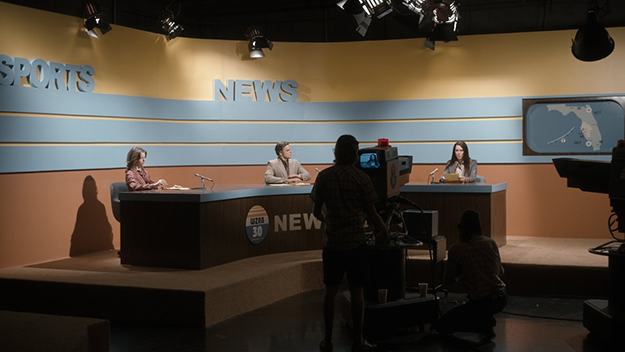
Campos tunes his direction to micro-nuance. He enables us to enjoy newsroom banter yet pick up on how it goes sour, or to judge how strange it must be for a couple of young lovers when Christine intrudes on them at a restaurant, then introduces herself as a reporter on the lookout for positive stories (she’s actually being embarrassingly wistful about her own lack of a love life). With his cameraman, Joe Anderson, Campos doesn’t shoot the action from predictable angles, or, with his editor, Sofia Subercaseaux, cut it according to familiar rhythms. The technical team and the ensemble work together seamlessly to convey how Christine feels when she’s moving in and out of synch with her colleagues, at the station and, even more stunningly, when the group gathers for a party at the owner’s house. She glides through like a workaholic wraith.
When it had its premiere at Sundance, Christine was immediately compared to Nightcrawler and, especially, Broadcast News: Hall’s Christine Chubbuck, like Holly Hunter’s Jane Craig, is the smartest person in the room and a bundle of insecurities. But Nightcrawler is a great nightmare satire about tabloid media breeding hollow men and women, while Broadcast News is an intelligent, charming light comedy about love and ambition among newsroom elites. When I was considering why Christine left me unsatisfied, and why Hall’s performance never quite reached greatness, the most useful comparison was to a very different movie—Jack Clayton’s masterpiece The Lonely Passion of Judith Hearne (1987), based on Brian Moore’s 1955 novel about “spinsterhood,” featuring Maggie Smith’s triumphant performance, as Judith Hearne, a single Dublin piano teacher who misperceives the attentions of her landlady’s brother (Bob Hoskins) much as Christine does George’s. Her circumstances are entirely different, but her personal frustration is identical. Being a virgin at 29 or 30 in sun-kissed Sarasota is as mortifying for Christine as being one at roughly 50 is for Judith in lace-curtain Dublin. (“She was a spinster at 29 and it bothered her,” her mother summarized for a TV reporter.) Yet Hall and Campos don’t make us feel the sensual frustration beneath Christine’s surface, the way Smith and Clayton do with Judith’s. Christine does give us one lovely moment when Chubbuck, anticipating a date, relaxes while conducting an interview and for an instant seems warm and sexy—perhaps star material. But the movie and the performance fail to illuminate what’s holding her back. The Lonely Passion of Judith Hearne is an outcry against the rigidity of Ireland’s Roman Catholic Church and the manipulations of Judith’s tyrannical aunt (Wendy Hiller). In Christine, the protagonist wails about her mother’s “hippie baloney,” which supposedly leaves her baffled by life. To the audience, though, her mother is a well-meaning woman stumbling forward on her own path to happiness.
Disappointingly, Christine coheres mostly as a put-down of the bad clothes, banal pop songs, and self-help therapies of the 1970s, the decade that gave rise to the workplace comedy of sitcoms like The Mary Tyler Moore Show and WKRP in Cincinnati. Campos has assembled a crackerjack cast for Christine’s work-mates. Early on, as George, Michael C. Hall is wonderfully funny and appealing. He suggests that he’s more than just a news hunk; he connects to Christine’s conflicts. So it’s crushing for her, and for us, when George’s secret wisdom turns out to be the Me Decade’s favorite pop psychology, Transactional Analysis; at moments of crisis, he’s reduced to repeating, “I’m OK, You’re OK.” Maria Dizzia gives an even more engaging performance as Christine’s friend Jean. Empathy streaks across her face as she registers her pal’s fluctuations. She’s touching when she urges Christine to “play hooky”—join her on an ice cream run and sing along with tunes on the AM hit parade, as Jean does when she gets the blues. Sure enough, she reacts to Christine’s suicide by scarfing down three scoops of ice cream and humming the Mary Tyler Moore Show theme song (aka “Love is All Around”).
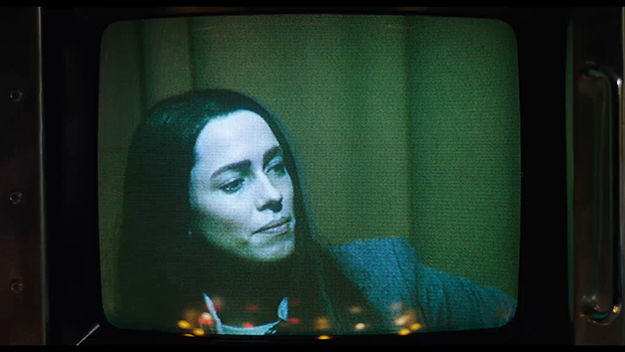
Is the movie blaming the culture at large for Christine’s floundering and for her colleagues’ inability to offer any meaningful help? For the audience, the problem seems to lie more with Christine herself—who she is, under that pressure, in that culture. According to the Post story following her death, R. Thomas Beason, a Presbyterian minister, said at her funeral: “We suffer at our sense of loss, we are frightened by her rage, we are guilty in the face of her rejection, we are hurt by her choice of isolation and we are confused by her message.” The movie conveys her rage, rejection, and isolation, but unfortunately doubles down on the confusion.
Michael Sragow is a contributing editor to Film Comment and writes its Deep Focus column. He is a member of the National Society of Film Critics and the Los Angeles Film Critics Association. He also curates “The Moviegoer” at the Library of America website.



